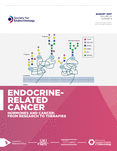T2-weighted MRI signal predicts hormone and tumor responses to somatostatin analogs in acromegaly
- Iulia Potorac1,
- Patrick Petrossians1,
- Adrian F Daly1,
- Orsalia Alexopoulou2,
- Sophie Borot3,
- Mona Sahnoun-Fathallah4,
- Frederic Castinetti4,
- France Devuyst5,
- Marie-Lise Jaffrain-Rea6,
- Claire Briet7,
- Florina Luca8,
- Marion Lapoirie9,
- Flavius Zoicas10,
- Isabelle Simoneau11,
- Alpha M Diallo12,
- Ammar Muhammad13,
- Fahrettin Kelestimur14,
- Elena Nazzari15,
- Rogelio Garcia Centeno16,
- Susan M Webb17,
- Marie-Laure Nunes18,
- Vaclav Hana19,
- Véronique Pascal-Vigneron20,
- Irena Ilovayskaya21,
- Farida Nasybullina22,
- Samia Achir23,
- Diego Ferone15,
- Sebastian J C M M Neggers13,
- Brigitte Delemer12,
- Jean-Michel Petit11,
- Christof Schöfl24,
- Gerald Raverot9,
- Bernard Goichot8,
- Patrice Rodien7,
- Bernard Corvilain5,
- Thierry Brue4,
- Franck Schillo3,
- Luaba Tshibanda1,
- Dominique Maiter2,
- Jean-François Bonneville1 and
- Albert Beckers1⇑
- 1CHU de Liège-University of Liège, Liège, Belgium
- 2Université Catholique de Louvain, Brussels, Belgium
- 3CHU Jean Minjoz, Besancon, France
- 4CHU Marseille, Marseille, France
- 5Université Libre de Bruxelles, Bruxelles, Belgium
- 6Department of Biotechnological and Applied Clinical Sciences, University of L’Aquila and Neuroendocrinology, Neuromed IRCCS, Pozzilli, Italy
- 7CHU Angers, Angers, France
- 8CHU Strasbourg, Strasbourg, France
- 9CHU Lyon, Lyon, France
- 10Universitätsklinikum Erlangen, Erlangen, Germany
- 11CHU Bocage, Dijon, France
- 12CHU Reims, Reims, France
- 13Erasmus University Medical Center Rotterdam, Rotterdam, Netherlands
- 14Faculty of Medicine, Erciyes University, Kayseri, Turkey
- 15University of Genova, Genova, Italy
- 16Hospital Universitario Gregorio Marañon, Madrid, Spain
- 17Hospital Sant Pau, Centro de Investigación Biomédica en Red de Enfermedades Raras (CIBERER, Unidad 747), IIB-Sant Pau, ISCIII and Universitat Autònoma de Barcelona (UAB), Barcelona, Spain
- 18CHU Bordeaux, Bordeaux, France
- 19Charles University, Prague, Czech Republic
- 20CHU Nancy, Nancy, France
- 21Moscow Regional Research and Clinical Institute, Russia
- 22Kazan State Medical Academy, Kazan, Russia
- 23Centre Pierre et Marie Curie, Algiers, Algeria
- 24Center of Endocrinology & Metabolism, Bamberg, Germany
- Correspondence should be addressed to A Beckers; Email: albert.beckers{at}chu.ulg.ac.be
Abstract
GH-secreting pituitary adenomas can be hypo-, iso- or hyper-intense on T2-weighted MRI sequences. We conducted the current multicenter study in a large population of patients with acromegaly to analyze the relationship between T2-weighted signal intensity on diagnostic MRI and hormonal and tumoral responses to somatostatin analogs (SSA) as primary monotherapy. Acromegaly patients receiving primary SSA for at least 3 months were included in the study. Hormonal, clinical and general MRI assessments were performed and assessed centrally. We included 120 patients with acromegaly. At diagnosis, 84, 17 and 19 tumors were T2-hypo-, iso- and hyper-intense, respectively. SSA treatment duration, cumulative and mean monthly doses were similar in the three groups. Patients with T2-hypo-intense adenomas had median SSA-induced decreases in GH and IGF-1 of 88% and 59% respectively, which were significantly greater than the decreases observed in the T2-iso- and hyper-intense groups (P < 0.001). Tumor shrinkage on SSA was also significantly greater in the T2-hypo-intense group (38%) compared with the T2-iso- and hyper-intense groups (8% and 3%, respectively; P < 0.0001). The response to SSA correlated with the calculated T2 intensity: the lower the T2-weighted intensity, the greater the decrease in random GH (P < 0.0001, r = 0.22), IGF-1 (P < 0.0001, r = 0.14) and adenoma volume (P < 0.0001, r = 0.33). The T2-weighted signal intensity of GH-secreting adenomas at diagnosis correlates with hormone reduction and tumor shrinkage in response to primary SSA treatment in acromegaly. This study supports its use as a generally available predictive tool at diagnosis that could help to guide subsequent treatment choices in acromegaly.
- Received 7 September 2016
- Accepted 20 September 2016
- Made available online as an Accepted Preprint 20 September 2016
- © 2016 Society for Endocrinology












